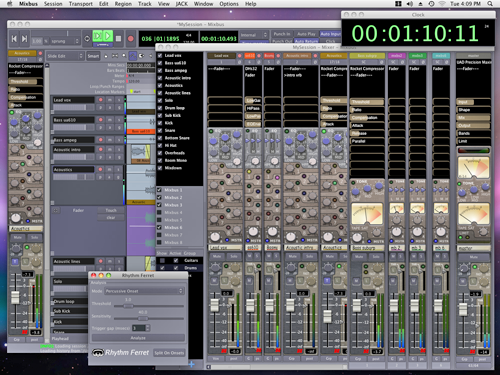
CAPABILITIES
Mixbus provides an infinite number of stereo and mono input channels and tracks, limited only by available CPU power. Each channel features a high-pass filter, parametric or quasi-parametric EQ, a compressor and eight buss sends. Each of the eight stereo mix busses includes tone controls, compression, side-chain control and analog tape saturation emulation, and each can be used either as a group or auxiliary return.
Also included is built-in delay compensation, as well as a phase button (Polarity) and Input Trim and Makeup Gain controls on every channel. The master stereo bus also features tone controls and analog tape saturation emulation, as well as K-metering, a stereo correlation meter and a limiter.
The integrated software editor has all the features and functions one would expect from a multitrack audio editor. However, its MIDI implementation is limited to controls and setting recall (which is, in pro recording studios, what we used MIDI for in the first place). Note that Mixbus is essentially a highly-customized version of Ardour, a fully open-source software program. However, Mixbus uses a lot of proprietary code developed by Harrison Consoles, and that’s what you pay for when you buy it. For simplicity’s sake we will refer to the entire business as Mixbus.
REQUIREMENTS
It runs on everything, that’s what. Mixbus is available for just about anything you have that will still boot up, and when you buy a copy you get the licenses for Mac, Windows and Linux machines. On the Mac you need OSX 10.4.11 or newer, rolling all the way forward to 10.8 (Mountain Lion), running on either an Intel or PPC (yes, G4 and G5 CPUs!), with a CoreAudio interface. On a Windows box it’s going to be looking for XP or later, on Intel or AMD, 64bit or 32 bit, and according to Harrison “...any system soundcard should work” although a modern ASIO interface will always give better sound and performance. Mixbus also runs on Linux, and is something I intend to fully test on UbuntuStudio in the near future, but for now I’m just impressed that it’s available. Harrison suggests that the CPU should have two or more cores or processors for best performance, which implies the software’s use of threaded processing for efficiency. 2 GB of RAM is absolutely the minimum requirement; I would suggest 8 GB to make Mixbus sing. More RAM yields the more memory space for the program to run, and the less fetching code from the hard drive, which is slow.
Mixbus supports a vast array of file formats for both import and export. Multiple file formats and sample rates can be utilized in a single session, and there’s even the obligatory option to export finished projects directly up to your SoundCloud account.
Note that both the Mac and the Linux versions come with an audio routing program called JACK, which can allow the Mixbus mixer to replace the mixer in another multitrack editor by routing its output into the Mixbus. It should also be noted that on the Mac one has to employ a small workaround if one wants to use the built-in audio; one creates an OSX “aggregate” device that combines the built-in speakers and inputs together, and ties those separate devices into a single duplex device. No similar workarounds are required on Windows or Linux, but a good audio interface couldn’t hurt.
Authorization is accomplished via a serial number file which is downloadable along with the software itself. The software license is specifically for one user, which means that Mixbus can be installed on several computers, so long as only one copy is in use at a time, being used by the licensee who paid for it.
